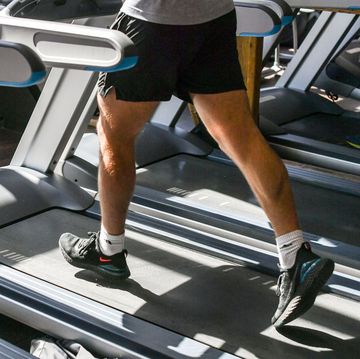Essentially a measure of your cardiovascular fitness or aerobic capacity, your VO2 max is often considered a must-know metric if you’re a runner – especially if you’re looking to improve your running speed, efficiency and overall performance. Measured in mL/kg/min – which, in long terms, refers to the maximum amount of oxygen a runner can consume in millilitres per kilogram of body weight in one minute – your VO2 max is presented as a number and the higher it is, the better your cardiovascular fitness.
While factors such as your age, gender and genetics affect your VO2 max, a 2024 study published in Cureus concluded that athletes across the board had higher VO2 max scores than non-athletes of the same age and gender when tested on a treadmill or a bicycle ergometer. With that in mind, keeping up that fitness routine really will pay dividends for your health.
Although many smartwatches can now measure your cardiovascular fitness to a high degree of accuracy, doing a controlled test in a lab, on a treadmill, is often seen as the most definitive way to pinpoint a runner’s VO2 max. That said, while lab tests lead the way when it comes to precision, not all runners need to (or should) do one. So, before you jump on the bandwagon, read on to find whether you would actually benefit from the results of a VO2 max test.
What everyone's reading
What is VO2 max and how do you test it?
Physiologically, VO2 max is a measure of how efficiently your body takes oxygen and converts it into energy for your muscles to use.
In theory, then, the higher your VO2 max, the higher your cardiovascular fitness and endurance – but it’s still more nuanced than that. As mentioned before, your VO2 max is based on multiple factors, some of which are modifiable and some of which are not.
‘Some of it is purely genetic and based on your muscle make-up, what type of muscle fibres you have, the capacity of your lung volume and how efficiently the airways in your lungs can absorb oxygen,’ says James Robinson, a sports medicine physician based in New York City, who also notes age and gender as factors that affect your VO2 max. ‘But other aspects can be modified with training.’
VO2 max tests conducted in a lab – which often have you run on a treadmill at an increasingly harder effort while wearing a mask to gauge your oxygen use – are the most clear-cut way to learn your VO2 max. However, many wearables from Garmin, Apple, Samsung and others can still give you a solid measure of your VO2 max based on wrist sensor data. While experts say that the accuracy of such wearables varies, this data is probably sufficient if you’re looking to track your VO2 max trend over a longer period. In fact, one study – conducted by researchers at the University of Cambridge and published in npj Digital Medicine – determined that, over time and with the right algorithm, wearables can provide lab-standard VO2 max results.
Who should do a VO2 max test in a lab?
According to the experts that we consulted, you should only get a VO2 max test in a lab if you know how you’re going to use the information that you get.
For example, if you’re new to running – and likely have a lot of room for VO2 max improvement – it could be useful to do a VO2 max test in a lab so you have a very accurate benchmark. ‘It gives you a number to say, “Okay, this is where I’m starting from”,’ says Ben Delaney, Director of Training Programs and Operations at New York Road Runners.
Plus, since there are now established averages for VO2 max based on age and gender, knowing your own, current VO2 max score can help you to see how your cardiovascular fitness compares with others’.
A VO2 max test in a lab can also be handy for advanced runners – especially sprinters – who can use the resulting data for their training. This is particularly true for speed sessions, for example, where runners complete intervals at 80% of their VO2 max. ‘Knowing your VO2 max is useful so you know where to train at the highest intensity to improve your overall cardiovascular fitness,’ says Robinson.
One caveat here is that top-tier runners are more likely to be at their ceiling already, with little room left for VO2 max improvement. So, for some, this may be discouraging. ‘There is a plateau with your anaerobic capacity [and] you can keep working till the cows come home,’ says Delaney, who points out that your body, eventually, will not be able to reach the next level.
Meanwhile, if you just love data and having fun with running-related numbers, then VO2 max tests in a lab probably present little real risk (other than to your wallet – these tests do come at a price). Plus, if you have a wearable, you can compare the data to see how accurate it really is.
If you do decide to head down the lab test route, Greg Laraia, a running coach at Motiv in New York City, suggests doing one every six months so you have enough time to make some progress in between each test. Even better, he recommends aligning your VO2 max tests with races. For example, you could get a lab test before you start training for a 5K or a 10K, then retest either right before or right after your race. ‘The cool thing about that is you’ll have a new baseline in terms of intensity for your next training cycle,’ says Laraia.
Who can skip a VO2 max test in the lab?
Most recreational runners probably don’t need to do a VO2 max test in the lab. As mentioned, most wearables do a good job of measuring VO2 max in a more economical and convenient way.
What’s more, runners who are hyper-competitive might find the lab data more harmful than beneficial. ‘Some people are a little too competitive and can get too fixated on these numbers,’ says Robinson.
Laraia, too, cautions against comparing your score with other people’s, since VO2 max is so multifaceted and unique to the individual. Besides, it won’t confirm whether or not you’ll be faster than them in a race. Laraia, for instance, once conducted a VO2 max test on an underwater welder with no running experience. While the underwater welder obtained an extremely high VO2 max score due to the physical nature of his day job, he probably wouldn’t do so well in a 5K race without any training.
If you’re currently training for a long distance event like a marathon, you may also want to skip or at least hold out on a VO2 max test. That’s because the type of workout required to most effectively increase your VO2 max is high-intensity interval training (HIIT) – and, according to Robinson, overdoing it at any time, especially during a marathon training block, can lead to overtraining and injury. More specifically, HIIT can put undue stress on your tendons, bones and ligaments, especially if you are already doing a lot of mileage in the week.
In this case, Robinson says that ‘trying to focus on improving your VO2 max can actually be detrimental to your overall goals’ – and training to improve your VO2 max is best done when you don’t have a distance race on the calendar. ‘I think you should be focusing on just getting your body used to that type of mileage.’
In addition, Laraia says that you might want to skip a VO2 max test in the lab if you tend to get overwhelmed by data and numbers. Sometimes, knowing too much about your fitness levels complicates training, when all you really need to do is follow a solid training plan that mixes some intervals into a week of easy runs.
Finally, it’s worth noting that you don’t need to do a VO2 max test if it’s not in your budget. ‘Some of this testing can be expensive, so it may not be financially feasible for everybody to do it,’ says Robinson. ‘I don’t think that it’s necessarily something runners have to know.’
Laraia, for his part, says that it might ‘cool to see’ the results of a VO2 max test. However, he still feels that he gets enough data from his running watch and heart rate monitor to help him assess his progress.
What other metrics can runners focus on?
Before you sign up for a lab visit, you might want to consider a couple of alternatives to VO2 max testing.
The first is a simple gait analysis. ‘Let’s say you’ve had a lot of running-related injuries – in this case, a running analysis is probably more useful [than a VO2 max test] to find some abnormalities in your gait that have made you more prone to injury,’ says Robinson.
The second is a metabolic profile test, which encompasses VO2 max. This can benefit those who are looking to achieve a specific race time, or who want to run faster more generally. Robinson, in particular, says that knowing your lactate threshold (another part of the metabolic profile test) is probably more important in the long run if these are your goals.
Other metrics that the experts say can help to identify improvements in your cardiovascular fitness include your running pace, your rate of perceived exertion during runs and your weekly mileage. If you’re increasing your weekly mileage, you’ll be building your aerobic capacity.
Finally, Laraia says that keeping tabs on your resting heart rate can be beneficial, as a downward trend would imply increased cardiovascular fitness.













